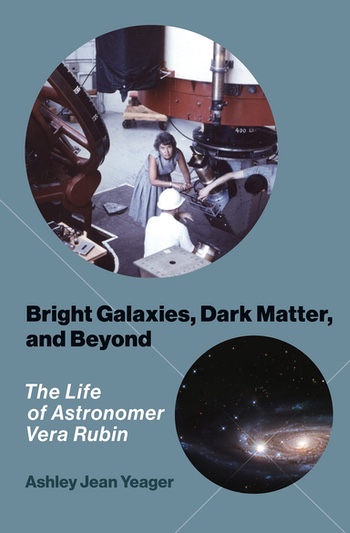Review: Bright Galaxies, Dark Matter, and Beyondby Jeff Foust
|
| The book helps paint a full picture of Rubin the person and Rubin the astronomer, both pushing the boundaries of our knowledge of the universe but also the boundaries of women in a profession that had long been hostile to them. |
Rubin, who died in late 2016, was an astronomer best known for her work measuring the rotation curves of those galaxies. The flat shape of those rotation curves indicated that galaxies were embedded in a much larger volume of invisible matter: the strongest evidence of the existence of dark matter. Her life and career are chronicled in a recent biography, Bright Galaxies, Dark Matter, and Beyond, by Ashley Jean Yeager, an editor at Science News.
Rubin was fascinated by astronomy from an early age and decided to major in the field when she went to Vassar College. As a woman in astronomy in the middle of the 20th century, she was often on a solo path: even at Vassar she was the only student in her class studying astronomy. As a graduate student at Cornell, she did research on whether there was a rotation of the universe, which her advisor found interesting—then offered to present it at a conference under his own name. (She declined, making the presentation herself just weeks after giving birth to her first child.)
Rubin, though, was more than willing to seize opportunities as they arose or create them herself. That led her to work on measuring the rotation of galaxies starting in the 1960s, finding those flat rotation curves that provided, over the years, compelling evidence of the existence of dark matter—even if no one, then or now, knew for certain what dark matter is. That became what she was best known for in astronomy, and was research that won het numerous awards.
Yeager interweaves Rubin’s career and personal life with the state of the field of astronomy throughout her career, including from interviews with Rubin herself several years before her 2016 death. That helps paint a full picture of Rubin the person and Rubin the astronomer, both pushing the boundaries of our knowledge of the universe but also the boundaries of women in a profession that had long been hostile to them.
Inevitably, the book turns to the issue of whether Rubin deserved a Nobel Prize for her research confirming the existence of dark matter. Some astronomers argue that the idea of dark matter predated Rubin’s research by decades, and there is still no consensus on what that dark matter is. Others note that other astronomers won Nobel Prizes for discoveries providing evidence of dark energy without any understanding of what that is either. Yeager writes that Rubin herself was conflicted about the prize: “She even said that if she’d won it, she’d be thrilled, but she wasn’t sure she really wanted it. It changed your life, she feared, and not always in a good way.”
In Chile, the Rubin Observatory is facing a series of challenges, from delays caused by the pandemic to interference in its observations from satellite megaconstellations. However, Rubin the astronomer overcame many challenges of her own to become an astronomer who reshaped our knowledge of the cosmos; hopefully, its namesake can do the same.
Note: we are using a new commenting system, which may require you to create a new account.
